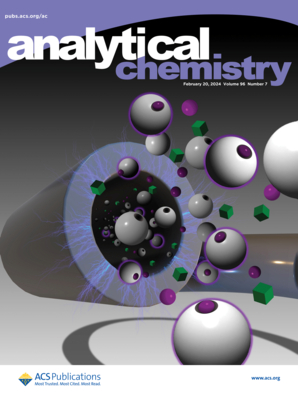Open Type Solid Photoacoustic Trace Gas Sensor with Multi-Pass Absorption Enhancement.
IF 6.7
1区 化学
Q1 CHEMISTRY, ANALYTICAL
引用次数: 0
Abstract
A wavelength modulation solid photoacoustic spectroscopic (WM-SPAS) sensor enhanced with an open-type multi-pass cell (OMPC) is reported for highly sensitive detection of trace gases, especially suitable for highly corrosive and long optical-to-thermal (non-radiative) relaxation gaseous species. Such open configuration is quite different from traditional trace gas detection methods in that the separation design of the acoustic signal detector and gas absorption cavity avoids the adversely corrosive effect and reduces signal fluctuations caused by high flow rates. The modulated beam after the optical absorption by the target gas in the designed open-type multi-pass path is directed into a self-designed solid chamber, filled with carbon powder while the photoacoustic (PA) pressure signal is analyzed to yield the target gas concentration. By optimizing the incident beam angle, the OMPC achieves 96 reflections, yielding a 9.6 m optical path length enhancement. Using acetylene (C2H2) as a test sample and a DFB laser as the excitation source, this WM-SPAS sensor achieves sensitivity of 80 ppb and corresponding normalized noise equivalent absorption coefficient equal to 2.42 × 10-9 cm-1 W/Hz-1/2 with 1 s time constant and modulation frequency as low as 39 Hz, which enables the sensor to detect gases with slow non-radiative relaxation. An Allan deviation analysis indicated the minimum detection limit could be further improved to 7 ppb at 100 s integration time. The response deviation of the PA signal under different flow rates was characterized by a coefficient of variation of 0.71‰. With its separate structure design, this newly developed PAS trace gas sensor offers unique advantages for open trace gas detection in high-flow and corrosive environments.具有多通道吸收增强的开式固体光声微量气体传感器。
报道了一种波长调制固体光声光谱(WM-SPAS)传感器,该传感器采用开放式多通电池(OMPC)增强,可用于高灵敏度的痕量气体检测,特别适用于高腐蚀性和长光热(非辐射)弛豫气体。这种开放式配置与传统的微量气体检测方法有很大的不同,声信号探测器与气体吸收腔的分离设计避免了不利的腐蚀作用,减少了高流量引起的信号波动。在设计的开式多通路中,经过目标气体光吸收的调制光束被引导到自己设计的充满碳粉的固体腔室中,同时分析光声(PA)压力信号,得到目标气体浓度。通过优化入射光束角度,OMPC实现了96次反射,产生9.6米的光程长度增强。该WM-SPAS传感器以乙炔(C2H2)为测试样品,DFB激光器为激发源,在1 s的时间常数和低至39 Hz的调制频率下,灵敏度可达80 ppb,归一化噪声等效吸收系数为2.42 × 10-9 cm-1 W/Hz-1/2,能够检测到慢速非辐射弛缓气体。Allan偏差分析表明,在100 s的集成时间内,最小检测限可以进一步提高到7 ppb。不同流量下PA信号响应偏差的变异系数为0.71‰。凭借其独立的结构设计,这款新开发的PAS微量气体传感器为高流量和腐蚀性环境中的开放式微量气体检测提供了独特的优势。
本文章由计算机程序翻译,如有差异,请以英文原文为准。
求助全文
约1分钟内获得全文
求助全文
来源期刊

Analytical Chemistry
化学-分析化学
CiteScore
12.10
自引率
12.20%
发文量
1949
审稿时长
1.4 months
期刊介绍:
Analytical Chemistry, a peer-reviewed research journal, focuses on disseminating new and original knowledge across all branches of analytical chemistry. Fundamental articles may explore general principles of chemical measurement science and need not directly address existing or potential analytical methodology. They can be entirely theoretical or report experimental results. Contributions may cover various phases of analytical operations, including sampling, bioanalysis, electrochemistry, mass spectrometry, microscale and nanoscale systems, environmental analysis, separations, spectroscopy, chemical reactions and selectivity, instrumentation, imaging, surface analysis, and data processing. Papers discussing known analytical methods should present a significant, original application of the method, a notable improvement, or results on an important analyte.
 求助内容:
求助内容: 应助结果提醒方式:
应助结果提醒方式:


